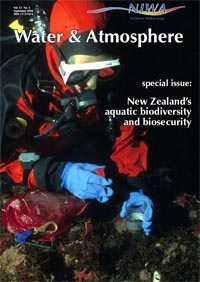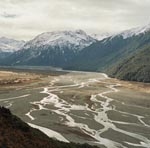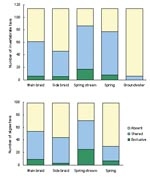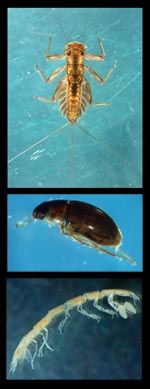PDF of this article (211 KB)

Cathy Kilroy Mike Scarsbrook Graham Fenwick
“Look after the springs and you look after the river”. A bit simplistic, perhaps, but it’s a good starting point for conserving aquatic biodiversity in braided rivers.




Seen from a high vantage point, New Zealand’s braided rivers – those bright, winding ribbons of water in a sea of gravel – are unforgettable. The seemingly barren gravel landscape provides important habitat for many species of native wading birds, some unique to this environment. But what is the status of the unseen aquatic biodiversity of tiny invertebrates and microscopic algae on which these birds and other animals ultimately depend?
We know surprisingly little about natural patterns of aquatic biodiversity in large braided rivers, especially compared with those of smaller gravel-bed rivers. Previous scientific studies that have examined biodiversity in large systems have tended to concentrate on the main river channels. In a recent survey in the Waimakariri River, Canterbury, we sampled multiple habitats. Our results showed that, despite differing patterns in distributions and biodiversity of invertebrates and algae, one habitat type stood out as having particularly high biodiversity values.
A multi-dimensional environment
From a bird’s eye view, the linkages between a large braided river and its floodplain, and between the river and the mountains that feed it, are strikingly obvious. Less obvious is the important linkage between the river and underlying groundwater. Surface waters continually move down through the gravels of the riverbed, mix with underlying groundwater, and then reappear across the floodplain, often as small springs. Together, the river, floodplain and groundwater constitute a complex three-dimensional environment, which is made even more complex by changing patterns through time. All this creates an intricate and ever-changing mosaic of aquatic habitats for small organisms: groundwaters, springs, spring-fed streams, quiet side braids, and turbulent main braids (see diagram). From a biodiversity perspective, an important question arises: What is the contribution of each of these habitats to biodiversity in the river as a whole?
In summer 2003, NIWA biologists began to investigate this question with a survey of invertebrates and algae in the braided sections of the Waimakariri River. We sampled a range of habitats at three sites: near the headwaters, in the central reaches and downstream close to the sea.
Spring streams: centres of biodiversity
The samples from all habitats together yielded 114 invertebrate and 99 algal taxa.
For the invertebrates, community composition was clearly different across habitat types. Groundwater habitats had a very distinctive fauna, with low numbers of a few specialist subterranean taxa (see “Lightless, not lifeless”). The main river and side braids shared very similar faunas. Mayflies, worms and midge larvae dominated and only 15 of the 114 taxa were exclusive to these river habitats. Springs and the spring streams they fed contained the most diverse invertebrate fauna, and 45 of the taxa we found were restricted to these habitats (see graph).
The most obvious pattern for the algae was that green filamentous algae dominated almost all samples collected from the central and downstream sites, regardless of habitat type. None of the upstream samples was dominated by green algae. Overall, diatoms were the most diverse type of alga, accounting for 65 of the 99 algae species found. About 20% of the diatom species made up a river-wide diatom flora that occurred at all three sites and in all habitats. Of the remaining diatom species, 16 were found only in spring-stream habitats. Only seven species were exclusive to the main river, one was exclusive to side braids, and five to springs. Over 25% of all the algal taxa found were exclusive to spring streams.
So, although invertebrate and algal biodiversity showed different patterns, spring streams emerged as important centres for biodiversity for both groups of organisms.
Different controlling factors
The differences we observed between biodiversity patterns in invertebrates and algae can be explained by the factors that control community composition in the two groups.
Many of the invertebrate taxa were typical of fast-flowing, clean, gravel-bed rivers, with some variations according to substrate type (e.g., cobbles versus sand). However, the groundwater linkage in this large system contributes additional taxa according to how closely connected the habitat is to groundwater. The relative stability of spring creeks, compared to main and side braids, also allows colonisation by invertebrates that will not tolerate the unstable, flood-prone environment of the active river channel.
Algal growth and community composition are more directly influenced by water chemistry. Increased nutrient levels probably explain much of the dominance of filamentous algae at the downstream sites. Algal biodiversity is also a function of bed stability. Thus, habitats that are rarely washed out by floods – such as some of the spring-fed streams – can accumulate new taxa that gradually migrate down from the wetlands, pools and creeks that feed the headwaters of the river.
Springs need protection
Throughout a braided-river system, the distribution and permanence of springs and spring streams varies with river and groundwater levels – a reflection of the multi-dimensional nature of the rivers. This has major implications for the management and protection of biodiversity values in braided rivers, which face increasing pressure from demands for water for irrigation and hydro-electricity generation. In order to protect these special ecosystems we need to understand how they function in all dimensions and how their core values can be protected, while providing the water needed for human uses.
Our one-off survey has confirmed the high biodiversity values of spring-fed streams. Work in progress aims to assess the effects of fluctuating flows and the permanence of spring and spring-stream habitats on all habitats in the river, thus bringing the time dimension into the equation. The results of this work should help us to understand how to balance water abstraction demands with environmental values, especially maintaining indigenous biodiversity.
Cathy Kilroy and Graham Fenwick are based at NIWA in Christchurch; Mike Scarsbrook is at NIWA in Hamilton.
Teachers’ resource for NCEA AS: Biology 2.1, 2.4, 2.5, 3.2; Geography 2.1, 3.1. See other curriculum connections at www.niwa.co.nz/pubs/wa/resources
Acknowledgements
This study was funded by the Department of Conservation and the FRST programme “Biodiversity of NZ Aquatic Environments” (C01X0219).
